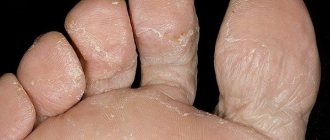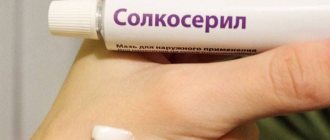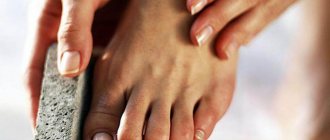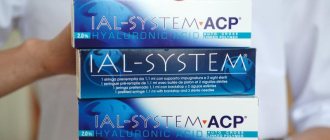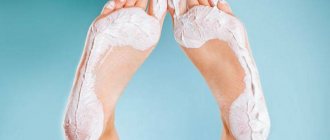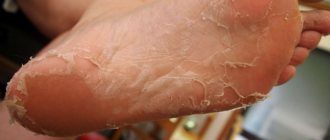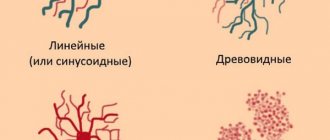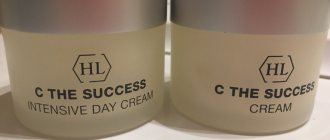Only babies can have ideally soft heels, because they have not yet stood on their feet. As we grow older, the skin on our feet becomes rougher. This occurs due to tight shoes, dehydration, and walking barefoot. In short, there are a lot of reasons. But I really want to find an effective way to soften the rough skin of my feet and have soft feet like a baby’s.
Causes of rough skin on heels and feet
The feet are our support and every day the feet bear the entire load of the body. Just imagine how much they have to endure: walking barefoot on hot sand, heels, stuffy shoes, dancing, sports. Under pressure, the skin grows a stratum corneum to protect against damage. This is what we are trying so hard to get rid of. Under a dry and dense layer of rough skin, our feet are tender and soft.
What causes rough feet and heels?
- Body weight, even if it is within the normal BMI - body mass index.
- Shock load from any activity. When dancing, walking, running, our feet take the impact, and when we jump, they bear a load 8 times our weight.
- Dehydration. Lack of fluid = dry and rough skin.
- Hormonal changes during lactation and menopause make the skin drier.
- Walking barefoot on the seashore, sand and salt water draws moisture from the feet.
- Thick synthetic socks and shoes that don't fit properly interfere with blood circulation.
- Using an overly hard file or cutting off the roughened part “under the root” leads to the opposite effect: the skin is protected and the stratum corneum grows even more actively.
- Improper foot care. It is important to regularly cleanse, steam and moisturize your skin.
- Vitamin deficiency, which is most active in the cold season.
The condition of the feet also serves as an indicator of well-being. The appearance of rough skin can cause various health problems:
- Estrogen deficiency. Constant peeling of the skin of the feet and the appearance of cracks with proper care is a reason to visit an endocrinologist and take a blood test. Estrogen levels have a great influence on a woman’s beauty and the speed of skin regeneration. When it is low, corns, rough skin on the heels and cracks appear, which can become inflamed.
- Thyroid gland dysfunction. If you are overweight, the wounds on your feet are not healing well, and your skin is peeling, this may indicate hypothyroidism - a decrease in thyroid function. This syndrome affects the production of hormones, fat and carbohydrate metabolism, and can provoke diabetes.
- Condition of individual organs. As you know, there are a huge number of acupuncture points on the feet, associated with different human organs. Based on the condition of the skin on the reflex zone, you can determine the problem in one of them. Foot massage is also useful for prevention, relaxation and generally improves health.
- Flat feet. Corns occur due to deformation of the foot. It can be caused by flat feet, wearing tight shoes and high heels. If flat feet are not diagnosed, then when you change your shoes to comfortable ones, the corns will disappear. If you have flat feet, you should order individual orthopedic insoles that correctly distribute the load on the foot.
- Joint problems. Horseshoe-shaped calluses on the heels are often a sign of weak joints. They are formed when the load is placed on the edge of the heel due to deformation of the hip and knee joints or problems in the lumbar spine.
Skin diseases
Skin problems on the legs can be the result of dermatological diseases or infections.
These include:
- Eczema. A hereditary chronic disease, the development of which is provoked by allergies, reduced immunity, stress, and infections. With eczema on the feet, the skin becomes very dry, itchy, red, and covered in a rash;
- Psoriasis. Chronic non-contagious disease with genetic predisposition. The impetus for the appearance of symptoms can be a change of season, rubbing the skin with clothing, infections, or certain medications. Psoriasis causes scaly, inflamed red patches;
- Lichen. An infectious disease caused by various fungal or viral pathogens. There are 5 types of lichen. Ringworm (microsporia) is usually found in children. Children of preschool age and primary schoolchildren who come into contact with street cats or dogs get sick more often. This type of lichen appears as pink spots with a flaky center.
How to get rid of rough skin at home
You can entrust the removal of rough skin to a professional or do it yourself at home. In the second case, you will need the following tools:
- Abrasive file for feet : roller or standard fine-grained grater.
- Scrub : We recommend natural salt-based scrubs, as they have an anti-inflammatory and restorative effect, while simultaneously cleansing and softening the skin.
- Moisturizing or nourishing foot cream : pay attention to products with aloe, panthenol, shea butter and shea butter.
- Foot bath : salt and oils in the bath take care of the skin, relieve fatigue and swelling, promote the healing of calluses, and also prepare the feet for exfoliation.
- Moisturizing socks or foot mask : an optional but very pleasant foot care product that moisturizes and softens calluses.
To summarize, we can distinguish 5 main stages of caring for rough skin on the feet.
What to do?
Have you noticed that your child's feet are flaky? Don't rush to the moms' forum for advice. If the condition does not improve after using moisturizing baby cream, consult a doctor. Parents' independent conclusions about the cause of skin changes are often erroneous. And lost time and improper treatment only worsen the situation, leading to cracks and infection. Therefore, be sure to consult a dermatologist.
To prevent peeling, make sure your child has:
- complete balanced nutrition;
- moisturizing foot cream with natural composition;
- strong immunity;
- proper foot hygiene;
- comfortable, natural shoes.
To monitor the condition and prevent foot diseases, we recommend that you and your child undergo periodic examinations by a podiatrist and undergo medical pedicures.
0 0
How to Cleanse Rough Skin with Foot Baths
A relaxing foot bath with salt and oils is a complete spa treatment that you can do at home at any time. By following the instructions, you will soften rough skin, relieve fatigue and enjoy foot care.
First you need to fill a container with hot water at a comfortable temperature, about 37-39 degrees. Dissolve the bath mixture in it at the rate of 1 tablespoon for every liter of water. 15-20 minutes are enough to steam the skin. Don't keep your feet in the water for too long, otherwise the water will cool down and you will get the opposite effect.
After steaming, you can start working with a file, grater and pumice. There may be a lot of skin at first, don't let that worry you.
Finish the treatment with a relaxing foot massage. Stretch each foot separately, rubbing it from heel to toes and back. Rub and twist each finger. Press the edges of your foot several times. Apply precise pressure and rub your foot, moving through all areas from the heel to the toes. Massage the heel with circular movements and pinching. At the end, you can stroke it and twist your leg a little in the joint.
After such a massage, local blood circulation in the feet improves, fatigue and swelling go away, and the skin well absorbs all the beneficial substances from the oil or cream. At night, the body undergoes the most active regeneration, so we recommend performing the procedure before bed.
Problem
Itchy skin can appear on any part of the body, but most often we experience it on the skin of the arms and legs.
It can begin at any time of the day, but it is especially unpleasant to experience itching at night, when it is most difficult for us to resist the urge to scratch the itchy area.
In addition, when we rest, the body produces less adrenaline and cortisone, but there is an increase in the production of the hormone histamine, which makes us feel itching even more. It can become a symptom of the development of an infection, in particular, foot fungus .
Which foot bath to choose?
The secret of the effectiveness of the baths lies in their natural composition, rich in magnesia and beneficial acids. The product is ideal for relieving fatigue and swelling, reducing inflammation, relieving pain after sports, moisturizing and nourishing the skin, preparing for a pedicure, as well as for people suffering from skin diseases. Epsom offers two foot baths that may interest you:
Foot bath “Foot Pleasure” with mint and lemon essential oil relaxes, relieves swelling and moisturizes the skin of the feet. A cooling bath will soothe discomfort and relieve swelling after sports or high heels, and the invigorating aroma of mint and lemon will instantly lift your spirits.
Epsom salt relaxes muscles, relieves pain and spasms. Salt removes excess fluid, quickly reducing swelling.
Sea salt relieves inflammation, promotes skin regeneration, healing of calluses and small wounds. Baths with sea salt reduce sweating and stop the development of nail fungus.
Lemon and mint essential oil restores tone to the legs, refreshes and relieves fatigue.
Tea tree essential oil has anti-inflammatory and antiseptic properties, improves blood circulation and fights fungus.
Sage essential oil soothes and heals damaged skin.
Macadamia oil nourishes and softens the skin, moisturizes the cuticle and takes care of the delicate skin of the feet.
Epsom Relax foot bath with chamomile and lavender essential oil nourishes the skin, relaxes muscles and relieves nervous tension. A warm evening bath with the aroma of lavender will give your feet lightness and comfort.
Epsom salts soothe muscles and relieve pain and spasms. Salt removes excess fluid, quickly reducing swelling.
Dead Sea salt relieves inflammation, reduces sweating, promotes the healing of small wounds, and effectively fights fungus.
Himalayan salt softens calluses and corns, accelerates skin regeneration, and tones.
Lavender essential oil soothes the skin and nervous system, helps you relax and fall asleep faster.
Tea tree essential oil has anti-inflammatory and antiseptic properties, improves blood circulation and fights fungus.
Chamomile extract relieves irritation and itching, soothes the skin after insect bites.
Macadamia oil nourishes and softens the skin, moisturizes the cuticle and takes care of the delicate skin of the feet.
Fungal infection
If your child likes to try on other people's shoes, walks barefoot in public places or goes to the pool, there is a risk that he has contracted a fungus.
In addition to peeling, this infection is characterized by the following changes in the affected area:
- itching;
- redness, inflammation;
- unpleasant odor;
- thickening of the skin;
- formation of microcracks.
It often happens that peeling is the only symptom. Parents may not suspect that it is a fungus. The skin between the toes usually suffers first, and then, if left untreated, the infection progresses.
To combat the fungus, antifungal agents are used, which are recommended by a dermatologist, mycologist or podologist. The sooner treatment is started, the easier and faster it is to get rid of the infection.
Recipes for home care for feet and heels
Foot baths, compresses and peeling are easy to make yourself using natural ingredients. We are happy to share the most effective recipes.
Foot baths
- Milk-soap bath . Fill a container with warm water at a comfortable temperature no higher than 40 degrees. Add half a liter of milk and a tablespoon of soap crumbs. Take a bath for about 15-20 minutes until the water cools down.
- Bath against profuse sweating . Brew 2 tea bags for every liter of water, wait until the temperature of the “tea” becomes comfortable and dip your feet in the resulting decoction. Black tea has the ability to tighten pores and also contains tannins that reduce sweating.
- Soda bath for corns . Dissolve 2 tbsp in water. spoons of baking soda and 1 tbsp. a spoonful of soap or shower gel. Take a bath for 15-20 minutes. The shower gel in this recipe can be replaced with sea salt, and you can also add your favorite essential oils.
- Lemon bath . Lemon juice destroys the stratum corneum of the skin and works as an acid peel. Dilute lemon juice with water in a ratio of 1:10. Add the resulting mixture to warm water and soak your feet for 10 minutes. Afterwards, rinse your skin with water to avoid drying out.
Home peeling
- Coffee peeling . Ground coffee is one of the main exfoliating ingredients in natural cosmetics. It improves blood circulation and also stimulates the production of collagen and elastin for renewed and firm skin. Mix 1 tbsp. spoon of coffee, 1 tbsp. a spoonful of cocoa and the same amount of cinnamon. Add 150 ml of any oil (olive, grape seed, macadamia) and tbsp. a spoonful of Dead Sea salt. Apply to skin with massaging movements, rinse after 10 minutes. If desired, you can use ready-made coffee scrub “Coffee Cocktail”.
- Classic salt peeling . Mix 50 gr. Dead Sea salt or Himalayan salt with 1 tbsp. spoon of olive oil. Add 5 drops of tea tree or lavender essential oil. Massage the mixture onto your feet and leave for a few minutes. Afterwards, rinse with warm water and apply cream.
- Kefir peeling . Heat 100 ml of kefir to 39 degrees, pour into a bag and lower your feet there for 2 hours. Afterwards, rinse off the residue with water and you can start sanding.
- Citrus peeling . Fruit acids perfectly soften rough skin and saturate it with vitamins. Any citrus fruits that you can find in the kitchen are suitable for peeling: orange, grapefruit, lemon, lime, tangerine. Grind a fruit weighing about 200 grams in a blender instead of peel and seeds. Add a sprig of finely chopped mint. Apply the mixture to rough areas of the skin and leave for 10 minutes, then rinse with water. Repeat acid peeling every week. The Slim Citrus mixture is also suitable for citrus peeling.
Foot compress
- Honey compress for the night . Mix a tablespoon of honey with 2 tablespoons of flour. Form a dense cake from the resulting mass and apply it to the steamed legs, covering the top with film. It is advisable to leave the compress overnight.
- Moisturizing compress with aloe juice . Mix aloe juice with onion juice and olive oil in equal proportions. Apply the mixture to your feet, cover with foil and go to bed.
- Softening compress with vinegar and glycerin . Glycerin is loved by cosmetologists for its ability to quickly heal wounds, moisturize and soften the skin. Mix 2 tbsp. tablespoons of pharmaceutical glycerin with an equal amount of 9% apple cider vinegar. Apply the solution to gauze and apply to areas of rough skin. Leave for several hours or overnight, covering with film and warm socks.
- Onion compress for rough skin on heels . For the recipe you only need one medium onion. Cut it in half, apply it to your heels and secure it with film and leave it overnight, putting socks on top. In the morning, throw away the onion, wash and file your heels.
Mask for feet and heels
- Nourishing potato mask . Mash the warm boiled potatoes with a fork and apply the resulting puree in a thick layer to your feet. Cover with cling film for half an hour, then rinse with warm water and apply your favorite cream.
- Moisturizing oatmeal mask . You will need 2 tbsp. spoons of oatmeal, 2 tbsp. spoons of olive oil and a spoonful of honey. Mix the ingredients thoroughly and apply to your feet. Cover with cling film and rinse with warm water after half an hour.
- Softening mask with semolina . Mix 2 tbsp. spoons of sea salt, 1 tbsp. spoon of honey, 1 tbsp. a spoonful of sour cream and half a glass of semolina. Apply the resulting mixture to your feet for 20 minutes, then rinse with warm water.
- Cleansing mask with Dead Sea salt . Mix Dead Sea salt and olive oil in equal quantities, add a teaspoon of cinnamon. Apply to skin with massaging movements, rinse after 10 minutes.
Removing rough skin: advice from cosmetologists
In conclusion, we want to give some tips that will help maintain the beauty and health of your feet.
- Use orthopedic insoles and forget about tight shoes that don’t allow your feet to breathe.
- Wear cotton socks even at home, and try not to walk barefoot.
- Throw away synthetic socks that interfere with normal thermoregulation.
- Do not use professional pedicure razors unless you have experience.
- Moisturize your feet daily and give them a proper spa every week.
Using the promotional code BLOG, all products from the article receive a 25% discount. Give your legs a day off!
